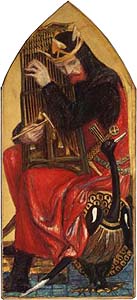
|
Old Testament
New Testament
Gospels
Acts
Paul's Letters
General Letters
Revelation
Topical Studies
Beginning the Journey (for new Christians). en Español

|
Old Testament
New Testament
Gospels
Acts
Paul's Letters
General Letters
Revelation
Topical Studies

|
Home
Bible Studies
Articles
Books
Podcasts
Search
Menu
Donate
About Us
Contact Us
FAQ
Sitemap
|
|
On any measure of Old Testament saints, David is in the first-tier, along with Abraham and Moses. The name "David" appears to be connected with the Hebrew verbal root dwd, "to love," so his name probably means "beloved."[1] He is an amazing, multi-faceted, multi-gifted person.
First, he was a musician, "the sweet psalmist of Israel" (2 Samuel 23:1). As a youth, he practiced the harp on the sheep fields of Bethlehem. As a young man he became a court musician for Israel's first King -- Saul. But as he grew, he began to write down the inspired songs or psalms that he wrote, so that his own compositions fill nearly half of the Book of Psalms.
But more than just a prolific lyricist and musician, David was a worshipper. His music wasn't just popular love songs. It was worship. It comprised the intense emotions of struggle and the high freedom of praise and everything in between. Music gave voice to David's faith and his soul-felt prayers.
Most musicians I know are gentle, artsy people. But David was the opposite. He was a renowned warrior, the most famous warrior in the history of Israel. His courage to stand up to and defeat Goliath is legendary. Saul made him an officer in his army where he began to win battles -- not by standing back and giving orders, but by leading his men into battle himself, defeating his foes by the strength of his arm -- and his faith in God! When Saul became jealous and began pursuing David, he gathered a band of 400 men, then 600, whom he forged into the fearsome army of a fugitive warlord. Because of his own courage and prowess as a warrior, he attracted the best warriors in the land to join him. David was a warrior.
But there's more to him. David was a nation-builder. Before him, Saul functioned as a local monarch over a loosely organized group of tribes. Through his own diplomatic efforts, David was able to unite these tribes into one nation. He conquered Jerusalem and made it capital of his growing empire. He built a palace, then brought the ark to reside in his new capital. Once he had consolidated power, David began to subdue the neighboring kingdoms that had pressured Israel's borders. He turned them into his vassals -- the Philistines, the Edomites, Moabites, and Ammorites. When he conquered Hadadezer king of Zobah, an Aramean overlord of kingdoms all the way east to the Euphrates River, David became king over an empire that extended from the Brook of Egypt in the Negev Desert east to the great river. David was a nation-builder.
Mythic Hero or Real Person?
When you realize the extent of David's influence as he "served God's purpose in his own generation" (Acts 13:36), it's amazing that some people have asserted that he didn't really exist at all, that he was merely a myth.
In the mid-twentieth century a group of "biblical minimalists" began to doubt publicly that David and Solomon and the United Monarchy ever existed. After all, they said, there were no archaeological inscriptions and no references in any ancient literature except the Bible. Minimalist Philip Davies went so far as to remark that he "suspects that the figure of King David is about as historical as King Arthur."[2]
This rather arrogant view, which is entirely dismissive of the Biblical record, rests on the weak assumption that all the available archaeological evidence has been excavated, though only a small amount has been unearthed to date. Fortunately, however, several archaeological inscriptions have surfaced that clearly point to the historicity of King David's reign:
- An inscription from an Old Aramaic stela in Tell Dan (dated about 840 BC) refers to the "House of David" in the context of a king.
- An inscription on the stela of Mesha King of Moab also refers to the "House of David" in about the same period.
- An inscription at Karnak by Pharaoh Shoshenq I records a victory over Rehoboam and Jeroboam in 926/925 BC referring to a place name in the Negev or south Judean area as the "heights of David," an inscription carved within 50 years of David's own lifetime.[3]
Was David a real person? Yes indeed!
Dating of David's Reign
When did David live and reign? The absolute date of David's reign is based primarily on counting backwards from a fixed event, specifically the Battle of Qarqar in 853 BC, in which Israel's King Ahab took part, as recorded on the Kurkh stela.[4] Dating is complex when you get into it. K.A. Kitchen determines the date for David's 40-year reign from about 1010 to 970 BC.[5] The primary scripture with relative dates of David's life is as follows:
"David was thirty years old when he became king, and he reigned forty years. In Hebron he reigned over Judah seven years and six months, and in Jerusalem he reigned over all Israel and Judah thirty-three years." (2 Samuel 5:4-5; cf. 1 Kings 2:11)
While it's difficult to pinpoint relative dates for events in David's life, Appendix 4 gives approximate dates and ages at various points in his life.
Composition and Authorship of 1 and 2 Samuel and 1 Kings
Our primary source material for the study of David's life is found in 1 and 2 Samuel and the first chapter of 1 Kings, with some supplementary information in 1 Chronicles.
First and Second Samuel are actually part of one book in the Hebrew Bible, along with 1 and 2 Kings. It wasn't until the Greek Septuagint translation in the second century BC that these books were divided, perhaps so they would fit on standard-length scrolls. In the Septuagint, these four books are known as Basileiōn A,B,C,D, the four books of the kingdoms.
Authorship is obscure. Obviously, the editors drew upon a number of contemporary sources, since some are mentioned, such as, the Book of Jashar (2 Samuel 1:18), and the books of the annals of Solomon and the kings of Israel and Judah (1 Kings 11:41; 14:19; 14:29), which have not been preserved. Scholars identify several probable source documents that are woven into the narrative, such as the History of David's Rise (1 Samuel 16 -- 2 Samuel 5:10 or 7:29) and the Succession Narrative (2 Samuel 9-20 and 1 Kings 1-2).
The composition of these books was widely debated in the twentieth century, but it is also obscure. Currently, their composition is seen as the work of one or more Deuteronomistic editors, perhaps first in the time of Josiah and then again during the exile.
Our text of 1 and 2 Samuel is derived primarily from three sources: the Masoretic Hebrew text, the Greek Septuagint translation, and Samuel manuscripts found among the Dead Sea Scrolls at Qumran. Of these, the Masoretic Hebrew text doesn't seem to have fared as well in transmission as the other two sources, though differences are minor.
Composition and Authorship of 1 and 2 Chronicles
First Chronicles adds quite a bit of material not included in 2 Samuel about David's involvement in preparing for building the temple, as well as in restructuring Levitical worship.
1 and 2 Chronicles were probably written sometime after the return from exile, as early as 527 BC and perhaps up to a century later. The purpose of Chronicles seems to be to help the returnees, most of whom had been born in exile, to gain a better understanding of who they are as the nation of Israel, a grasp of the David Covenant, and instructions concerning worship in the newly-constructed temple. We don't know much about the author or group of authors who composed Chronicles, except that they were probably Levitical scribes or priests. I refer to the author simply as "the Chronicler."[6]
Who Were the Philistines?
Before we get into the text itself, we need to examine the Philistines, Israel's neighbors to the west, with whom there is constant conflict during this period.
The Philistines apparently immigrated from the Aegean area in the early to mid-twelfth century BC. They settled primarily along the southwestern coastal strip of Canaan, the name "Palestine" deriving from the name "Philistine." The borders of Philistia are the Mediterranean on the west, the Brook of Egypt on the South, the low foothills of the Shepelah on the east, and the Yarkon River in the North, though at times they gained a foothold farther east into Israelite territory. They seem to have been a loose confederation of five city-states: Ashdod, Ashkelon, Ekron, Gaza, and Gath (Joshua 13:3b). For the most part these city-states waged war singly, but on occasion they gathered together to wage a common battle, such as the Battle of Gilboa against the Israelites, in which Saul and Jonathan were killed (1 Samuel 28:1; 29:1-11).[7]
 Available as a book in paperback, Kindle, and PDF formats. |
Of these cities, all but Gath have been positively identified in archaeological digs. Gath is probably to be identified with Tell es-Safi.[8]
Now that we've examined some of the introductory issues, let's turn to the events that ushered David onto the stage of history.
[1] David F. Payne, "David," ISBE 1:876.
[2] Philip R. Davies, "'House of David' Built on Sand: The Sins of the Biblical Maximizers," Biblical Archaeological Review, 20, number 4 (1994), p. 55.
[3] Kitchen, Reliability of the OT, pp. 90-93.
[4] Baldwin, 1 and 2 Samuel, p. 19.
[5] K.A. Kitchen, "Chronology," DOTHB, 183-184. K.A. Kitchen, On the Reliability of the Old Testament (Eerdmans, 2003), pp. 82-83. So John N. Oswalt, "Chronology of the OT," ISBE 1:673-685.
[6] Rodney K. Duke, "Chronicles, Books of," DOTHB, pp. 161-181; Martin J. Selman, 1 Chronicles: An Introduction and Commentary (Tyndale Old Testament Commentaries; Inter-Varsity Press, 1994), pp. 19-75.
[7] Carl S. Ehrlich, "Philistines," DOTHB, pp. 782-792; William S. LaSor, "Philistines," ISBE 2:841-846.
[8] Steven M. Ortiz, "Gath," DOTHB, pp. 305-309.
Copyright © 2026, Ralph F. Wilson. <pastor![]() joyfulheart.com> All rights reserved. A single copy of this article is free. Do not put this on a website. See legal, copyright, and reprint information.
joyfulheart.com> All rights reserved. A single copy of this article is free. Do not put this on a website. See legal, copyright, and reprint information.


